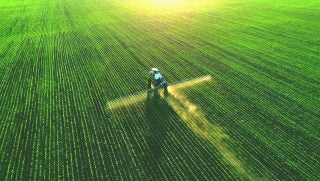Father/son duo Matt and Trent Henkes really know cows.
They also happen to be my neighbors who milk around 65 cows for Prairie Farms Dairy. Prairie Farms has always been one of my favorite dairy companies, primarily since they’re right in my neighborhood and pride themselves and very high quality milk from very small family farms like what the Henkeses have. While some dairies only source from a couple large-scale dairies, I enjoy seeing all the small dairies dot the landscape of my community. This is just personal opinion, although there’s nothing wrong with larger-scale farms either!
When dairy farmers produce milk, they get paid on volume, fat and protein content, and somatic cell count, which shows the amount of bacteria that may be present. It’s in any farmer’s best interest to produce the best, and for the Henkes family at Henkeseen Holsteins, their somatic cell count is around 98,000, which proves bacteria to be very low (many “typical” farms are between 100,000 and 150,000 cells per milliliter).
Although they don’t have a big milking herd, they add value to their farm on quality of cows, not quantity. This means they focus big time on their genetics and earn extra income by selling quality heifers and cows to other farmers, and they do cow shows on the side. Matt has a degree in Dairy Science from Iowa State and has loved cows his entire life. While in college he learned how to be a dairy judge and now works and judges some of the best of the best. On his Facebook page, he’s often showing off his herd like this:
Beautiful cows right? But what does all this mean, and what are judges looking for?
Matt explains that when he judges, he looks for high and tight udders (most important!), level rump, straight across the back, nice legs, and “dairyness.” Cows are shown when they’re at their prime lactation, and fat cows don’t milk well, so dairyness showcases how skinny they are. Dairy breeds are naturally on the skinnier side, so it showcases good genetics.
What about Matt’s post here — what do all the letters and numbers mean?
Think of it like a family tree for cows. The first photo here (top left) is Red Holstein breed Miss Ladd Sharlese. Her name is Sharlese, and they purchased her as a calf. Ladd was her father (also known as the sire), which is why it’s listed first and the letter P stands for polled, a gene she inherited that means she doesn’t have horns. She is now pregnant by Luxor (bull semen genetics through artificial insemination.) EX stands for excellent, and VG stands for very good. Cows are classified and given a number: 97 being the highest, 50 being the lowest. MS stands for mammary system, or udder.
This means that Sharlese is excellent all the way around (the best classification), and her pedigree shows her ancestors, if you will. Advent was the sire of Sharlese’s mother (called the dam), Budjon Redmarker Shar would be her grandmother, (scoring excellent 94!), etc. … great grandma was EX 93, great-great-grandma was an EX 94, so on and so forth.
The next couple photos shown here are her daughters and who they were bred to.
The fancy judging way of saying that this is Sharlese’s daughter named Spitfire is to use the full registered name: Henkeseen J Spitfire-P VG 86. Think of it like horse names … they can also be long and include the name of the dam or sire. But the full registered name for a cow cannot be longer than 27 slots, or characters. (VG 86 is not part of the name.) Henkeseen is the name of the farm. J stands for Jordy, which is her dad (sire), Spitfire is her name, P stands for polled (no horns), and her classification is very good with a score of 86, which is on a scale of 50 to 97.
Let’s try another one: Daughter by Ammo, Henkeseen Ammo Silver-P-Red.
This is another one of Sharlese’s calves named Silver. Henkeseen is the farm name, Ammo is the sire, Silver is her name. P is for polled, and red is because she’s a Red Holstein. She does not yet have a number or classification because she is still a heifer and has not yet had a calf. A heifer becomes a cow after she has a calf, and that’s when they can become classified and receive a number.
When she’s ready for breeding, farmers will use artificial insemination (AI) to choose the best genetics. Matt buys 10 or so units of semen at a time, which cost between $15 and $35 each, and then moves on to a different sire. This is a great explanation why AI is so popular:
When cows and heifers are shown, they’re judged based on phenotype (appearance and genetics) over milk production. That’s something I found interesting! But since farmers are paid on more than just production, it makes sense. Quality over quantity! And these animal are just that … beauty pageants queens of the dairy world. Matt travels the country showing cows and typically judges four to six shows a year, and his dream is to one day be a judge at the World Dairy Expo. This is like the “World Cup” or global “Super Bowl” of dairy bovines, and “judging” by his knowledge, it looks like he’s well on his way. Next time you look at cows, realize there is a lot of science that goes into the best quality milk and genetics!
Michelle Miller, the Farm Babe, is an Iowa-based farmer, public speaker, and writer, who lives and works with her boyfriend on their farm, which consists of row crops, beef cattle, and sheep. She believes education is key in bridging the gap between farmers and consumers.



